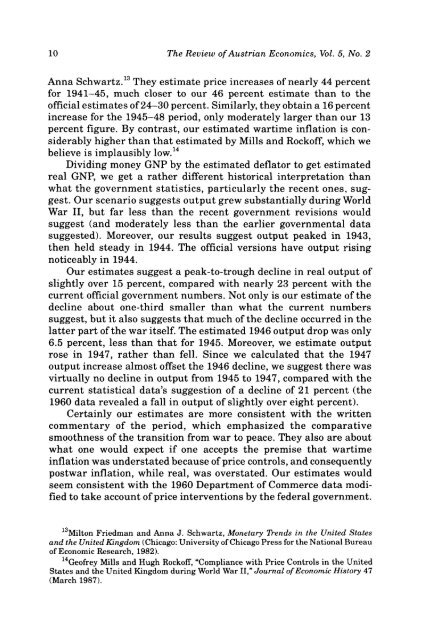Review of Austrian Economics - The Ludwig von Mises Institute
Review of Austrian Economics - The Ludwig von Mises Institute
Review of Austrian Economics - The Ludwig von Mises Institute
Create successful ePaper yourself
Turn your PDF publications into a flip-book with our unique Google optimized e-Paper software.
10 <strong>The</strong> <strong>Review</strong> <strong>of</strong> <strong>Austrian</strong> <strong>Economics</strong>, Vol. 5, No. 2<br />
Anna Schwartz. 13 <strong>The</strong>y estimate price increases <strong>of</strong> nearly 44 percent<br />
for 1941-45, much closer to our 46 percent estimate than to the<br />
<strong>of</strong>ficial estimates <strong>of</strong> 24-30 percent. Similarly, they obtain a 16 percent<br />
increase for the 1945-48 period, only moderately larger than our 13<br />
percent figure. By contrast, our estimated wartime inflation is considerably<br />
higher than that estimated by Mills and Rock<strong>of</strong>f, which we<br />
believe is implausibly low. 14<br />
Dividing money GNP by the estimated deflator to get estimated<br />
real GNP, we get a rather different historical interpretation than<br />
what the government statistics, particularly the recent ones, suggest.<br />
Our scenario suggests output grew substantially during World<br />
War II, but far less than the recent government revisions would<br />
suggest (and moderately less than the earlier governmental data<br />
suggested). Moreover, our results suggest output peaked in 1943,<br />
then held steady in 1944. <strong>The</strong> <strong>of</strong>ficial versions have output rising<br />
noticeably in 1944.<br />
Our estimates suggest a peak-to-trough decline in real output <strong>of</strong><br />
slightly over 15 percent, compared with nearly 23 percent with the<br />
current <strong>of</strong>ficial government numbers. Not only is our estimate <strong>of</strong> the<br />
decline about one-third smaller than what the current numbers<br />
suggest, but it also suggests that much <strong>of</strong> the decline occurred in the<br />
latter part <strong>of</strong> the war itself. <strong>The</strong> estimated 1946 output drop was only<br />
6.5 percent, less than that for 1945. Moreover, we estimate output<br />
rose in 1947, rather than fell. Since we calculated that the 1947<br />
output increase almost <strong>of</strong>fset the 1946 decline, we suggest there was<br />
virtually no decline in output from 1945 to 1947, compared with the<br />
current statistical data's suggestion <strong>of</strong> a decline <strong>of</strong> 21 percent (the<br />
1960 data revealed a fall in output <strong>of</strong> slightly over eight percent).<br />
Certainly our estimates are more consistent with the written<br />
commentary <strong>of</strong> the period, which emphasized the comparative<br />
smoothness <strong>of</strong> the transition from war to peace. <strong>The</strong>y also are about<br />
what one would expect if one accepts the premise that wartime<br />
inflation was understated because <strong>of</strong> price controls, and consequently<br />
postwar inflation, while real, was overstated. Our estimates would<br />
seem consistent with the 1960 Department <strong>of</strong> Commerce data modified<br />
to take account <strong>of</strong> price interventions by the federal government.<br />
13 Milton Friedman and Anna J. Schwartz, Monetary Trends in the United States<br />
and the United Kingdom (Chicago: University <strong>of</strong> Chicago Press for the National Bureau<br />
<strong>of</strong> Economic Research, 1982).<br />
14 Ge<strong>of</strong>rey Mills and Hugh Rock<strong>of</strong>f, "Compliance with Price Controls in the United<br />
States and the United Kingdom during World War II," Journal <strong>of</strong> Economic History 47<br />
(March 1987).

















